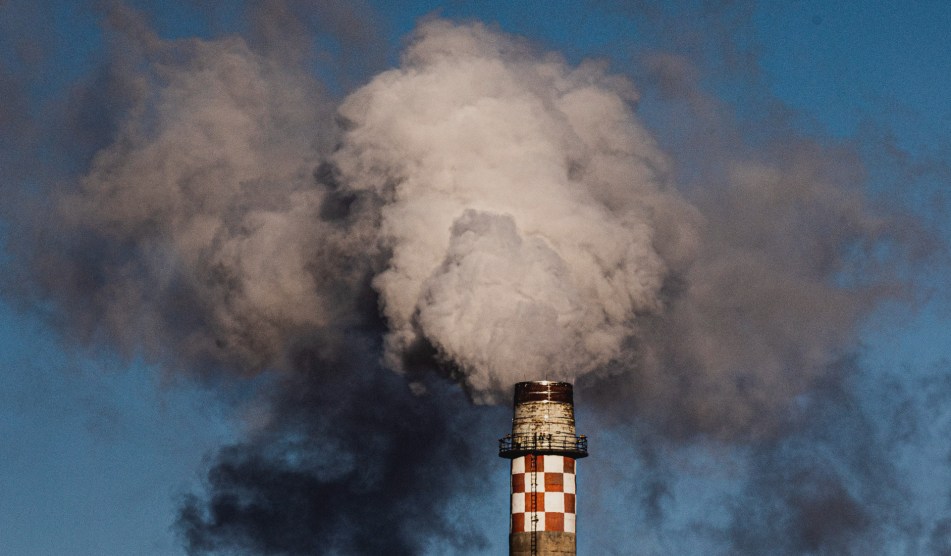
A chimney emits smoke in Germany.Florian Gaertner/Getty
This piece was published originally by Capital & Main.
What the hell is “net zero” anyway?
“Zero” is an elegant word, the last word in a descending line down a scale from something to nothing.
And so, among our nation’s biggest greenhouse gas emitters, it’s getting popular. ExxonMobil claims it’ll be heading there by 2050. So do Shell and Chevron (it’s in their links). Some 400 other signatories, including some of the world’s biggest companies outside the fossil fuel industry, have agreed publicly to a so-called Climate Pledge, sponsored by the king of overnight delivery Jeff Bezos, to achieve net-zero carbon emissions by 2040. A bandwagon is forming. Heading where?
U.N. Secretary General Antonio Guterres watched such claims falling like droplets from an atmospheric river at the climate negotiations last year and cautioned journalists to be wary of “net-zero commitments [that] have varying degrees of rigor and loopholes wide enough to drive a diesel truck through. We must have zero tolerance for net-zero greenwashing.” A U.N. report called out many “net zero” pledges as what it terms “dishonest climate accounting.”
But the press has too often given companies a free ride when it comes to their claims to be heading toward “net zero.” Even the world’s most prominent gathering of financial elites at the World Economic Forum — the ones who meet each year in the snowy ski chalets of Davos, Switzerland — cautioned against greenwashing by companies maneuvering for position in a suddenly climate-awakened world, and placed “net zero” at the top of their list of possibly misleading claims. Several regulatory agencies in this country and abroad have begun to watch for greenwashers far more closely than ever before in the context of false advertising.
The greenwash shared its moment of introduction into the Oxford English Dictionary with another prop of the late 1990s — Viagra. By now, 20-some years later, the green has been finessed over multiple wash cycles. When it comes to net zero, everything is in the fine print, and the print in ExxonMobil’s declaration, and those of its sister oil companies, is quite fine indeed.
Let’s take a brief foray into carbon accounting. There are three types of emissions, according to the EPA. Scope one are emissions from a physical facility — say, the 21 refineries that produce the 5.4 million barrels a day of ExxonMobil oil and other fossil fuel based products like plastic. Add another 109 refineries run by other companies (there are 130 total in the U.S., according to the Energy Information Administration) and you’ll get a picture of the oil industry’s carbon footprint from its refining operations. Scope two are emissions linked to production of the fuel necessary to keep the processing of fossil fuels running.
But Scope three emissions are where the action is, or isn’t: Those are the ones that result from the use of the final product, in this case the gasoline and other fossil fuels distributed across the land. The Union of Concerned Scientists estimates that Scope 3 accounts for 85% of total company greenhouse gas emissions.
In its net-zero statements, ExxonMobil makes no reference to Scope 3 emissions; same with Chevron. This is why in their promotional campaigns they can on the one hand be touting reduced emissions — mostly by imposing greater efficiencies on their own energy use — while opposing legislation that would reduce Scope 3 emissions, such as higher miles per gallon or promotion of electric vehicles. By promising to go “net zero,” they, like many other companies, simply move the goalposts or, more accurately, carry the ball to their own 15 yard line and call it a touchdown.
Nor are the oil companies alone in this accounting legerdemain: The shareholder action group As You Sow conducted a study of 55 of the country’s biggest companies and concluded that only six were reducing their emissions at all three levels, many of them while claiming to be going “net zero.” The group includes a listing of the “grades” for the 55 companies’ emissions performance: Microsoft at the top (“A”), Disney at the low end (“D-”) and Tesla at the bottom (“F”).
There are, however, ways to go net zero that do represent true declines in emissions. One business group, Science Based Targets, collaborates with the London-based Carbon Disclosure Project (CDP) to work with companies to devise plans that actually get them to net-zero emissions. That includes a commitment to reducing Scope 3 emissions, as well as the other two types. More than 400 global companies — many, but not all, are European — have signed on with policies approved for their emission-reduction potential by the independent CDP. These lists provide a helpful baseline for comparing the veracity of a company’s emission claims.
The International Energy Agency, the foremost global body conducting research and tracking trends in the global energy industry, also offers a list of actions that could actually lead to “net zero” by 2050. They all involve some version of ending or dramatically reducing our use of fossil fuels. The authors of the IEA report declare, “Achieving net zero emissions by 2050 will require nothing short of the complete transformation of the global energy system.” That’s a pretty high bar, but useful for any journalist trying to assess the veracity of net-zero claims.
The City Climate Sweepstakes
Curious how your city will fare as climate extremes accelerate? Hot off the press: Moody Analytics provides a handy picture of which cities will be facing the greatest economic damage from the climate extremes to come. Moody’s provides a cold-eyed view of the economic consequences of the double-sided extremes — droughts and deluges, the floods and the fires — ahead of us. And why is Moody’s issuing this report? While the rest of us try to survive the disasters, Moody’s clients will either be hit with the losses or reaping the profits. I won’t divulge the most vulnerable cities, but the list is a surprise.
Copyright 2023 Capital & Main












